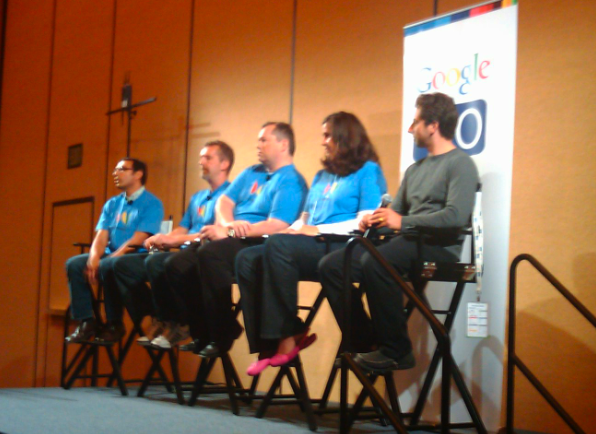Google’s New Wave Of Ambition
I’m in the Google Wave press conference, following a dizzying keynote — dizzying, at least, after a night of little sleep. As he did yesterday Google co-founder Sergey Brin joined the discussion and similarly apologized for arriving late. Danny live blogged the keynote earlier this morning. He jokingly compared Wave to Lotus Notes. In some […]
I’m in the Google Wave press conference, following a dizzying keynote — dizzying, at least, after a night of little sleep. As he did yesterday Google co-founder Sergey Brin joined the discussion and similarly apologized for arriving late.

Danny live blogged the keynote earlier this morning. He jokingly compared Wave to Lotus Notes. In some respects that’s not an entirely inappropriate comparison, given the scope of the product and the emphasis on collaboration — though the Google folks would probably disagree.
Wave seems to be conceived as a total communication and collaboration tool and therefore a successor and replacement for IM and email. In some respects then this is as ambitious as Android, perhaps even more so. It also encompasses mobile communication between users and mobile to PC communications in theory. The keynote presenters demo’d Wave on the iPhone and Android running in the browser.
One of the reporters in the in the room asked the panel about how they thought they were going to get people to change their behavior and abandon email for this new tool. Google responded that what they showed was an early “developer preview” and that there was still lots of work to do and a longish time horizon for the product. What wasn’t discussed was the way that social networks (and Twitter to a lesser degree) are taking the place of email in many instances. So it may not be such a huge problem to shift behavior in the end, provided the user experience is compelling to people.
Wave does seem to me to be a bit bulky and complex, from the blur of screens and demos I saw this morning sitting on the floor in a hall with more than 1,000 people. But the real-time aspect of it — the fact that you can actually see the other person typing — is pretty compelling.
This is a project that unfolded in Australia with 100 Google engineers and began in 2007. It was based on a general concept pitch to Brin by the developers, , who had previously built Google Maps. Based on that track record Brin said he approved the project and associated resources (not unlike a movie studio approves a pitch by a trusted director or producer). It sounds like Google has spent a bunch of money on this (no figures were discussed) and is pretty invested in its success.
There is no apparent business model (though one could imagine enterprise licensing) and Google intends to open-source it, which is probably smart from an adoption standpoint. Yet stepping back Wave is consistent with Google’s larger effort to move software and applications development into the browser and the cloud.
Contributing authors are invited to create content for Search Engine Land and are chosen for their expertise and contribution to the search community. Our contributors work under the oversight of the editorial staff and contributions are checked for quality and relevance to our readers. The opinions they express are their own.
Related stories